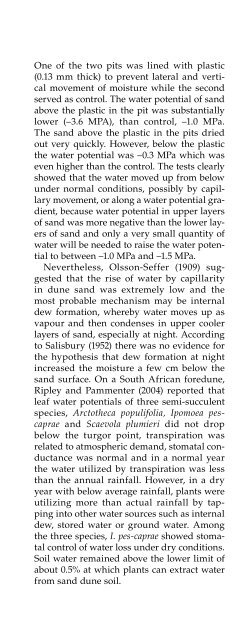The Biology of Coastal Sand Dunes M. Anwar Maun - Inecol
The Biology of Coastal Sand Dunes M. Anwar Maun - Inecol
The Biology of Coastal Sand Dunes M. Anwar Maun - Inecol
You also want an ePaper? Increase the reach of your titles
YUMPU automatically turns print PDFs into web optimized ePapers that Google loves.
One <strong>of</strong> the two pits was lined with plastic<br />
(0.13 mm thick) to prevent lateral and vertical<br />
movement <strong>of</strong> moisture while the second<br />
served as control. <strong>The</strong> water potential <strong>of</strong> sand<br />
above the plastic in the pit was substantially<br />
lower (–3.6 MPA), than control, –1.0 MPa.<br />
<strong>The</strong> sand above the plastic in the pits dried<br />
out very quickly. However, below the plastic<br />
the water potential was –0.3 MPa which was<br />
even higher than the control. <strong>The</strong> tests clearly<br />
showed that the water moved up from below<br />
under normal conditions, possibly by capillary<br />
movement, or along a water potential gradient,<br />
because water potential in upper layers<br />
<strong>of</strong> sand was more negative than the lower layers<br />
<strong>of</strong> sand and only a very small quantity <strong>of</strong><br />
water will be needed to raise the water potential<br />
to between –1.0 MPa and –1.5 MPa.<br />
Nevertheless, Olsson-Seffer (1909) suggested<br />
that the rise <strong>of</strong> water by capillarity<br />
in dune sand was extremely low and the<br />
most probable mechanism may be internal<br />
dew formation, whereby water moves up as<br />
vapour and then condenses in upper cooler<br />
layers <strong>of</strong> sand, especially at night. According<br />
to Salisbury (1952) there was no evidence for<br />
the hypothesis that dew formation at night<br />
increased the moisture a few cm below the<br />
sand surface. On a South African foredune,<br />
Ripley and Pammenter (2004) reported that<br />
leaf water potentials <strong>of</strong> three semi-succulent<br />
species, Arctotheca populifolia, Ipomoea pescaprae<br />
and Scaevola plumieri did not drop<br />
below the turgor point, transpiration was<br />
related to atmospheric demand, stomatal conductance<br />
was normal and in a normal year<br />
the water utilized by transpiration was less<br />
than the annual rainfall. However, in a dry<br />
year with below average rainfall, plants were<br />
utilizing more than actual rainfall by tapping<br />
into other water sources such as internal<br />
dew, stored water or ground water. Among<br />
the three species, I. pes-caprae showed stomatal<br />
control <strong>of</strong> water loss under dry conditions.<br />
Soil water remained above the lower limit <strong>of</strong><br />
about 0.5% at which plants can extract water<br />
from sand dune soil.<br />
Pr<strong>of</strong>ile (cm)<br />
160<br />
120<br />
80<br />
40<br />
0<br />
–40<br />
–80<br />
THE SAND DUNE ENVIRONMENT 27<br />
0600 hrs<br />
8 July 1979<br />
1400 hrs<br />
7 July 1979<br />
10 14 18 22 26 30 34 38 42 46<br />
Temperature (°C)<br />
Figure 2.5 Temperature pr<strong>of</strong>iles in and above the sand on<br />
a lacustrine sand dune system at 0600 and 1400 hrs in July.<br />
Horizontal bars represent ±1 SD (after Baldwin and <strong>Maun</strong><br />
1983).<br />
2.3 Soil and air temperatures<br />
On clear summer days the temperature <strong>of</strong> the<br />
surface layer <strong>of</strong> sand may reach up to 60°C,<br />
mainly because sand is a poor conductor <strong>of</strong><br />
heat owing to large pore spaces between particles.<br />
At the Pinery, the soil surface temperature<br />
reached 40 ± 6°C at 1400 hrs on 7 July 1979<br />
at the slack site (Fig. 2.5). However, immediately<br />
below the sand surface, temperature<br />
declined rapidly producing very steep lapse<br />
rates (Baldwin and <strong>Maun</strong> 1983). For example,<br />
at 5 cm below the sand surface, the temperature<br />
had decreased to about 30 ± 4°C, a drop<br />
<strong>of</strong> almost 10°C. <strong>The</strong> soil temperature continued<br />
to drop even further until it had reached<br />
19°C at 90 cm below the sand surface. In the<br />
evening, however, the situation was reversed.<br />
<strong>The</strong> thin hot surface layer <strong>of</strong> sand cooled rapidly<br />
because the low thermal conductivity <strong>of</strong><br />
sandy soil did not allow the replenishment<br />
<strong>of</strong> heat from lower layers <strong>of</strong> soil. Thus, there<br />
was a large diurnal temperature range at the<br />
sand surface. Olsson-Seffer (1909) recorded a<br />
diurnal temperature range <strong>of</strong> 25.6°C between<br />
day and night at the Hangö dunes in Finland.<br />
However, the diurnal range within the soil<br />
decreased with an increase in soil depth. At<br />
about 40 cm depth the soil temperature was<br />
the same both during the day and night. In

















